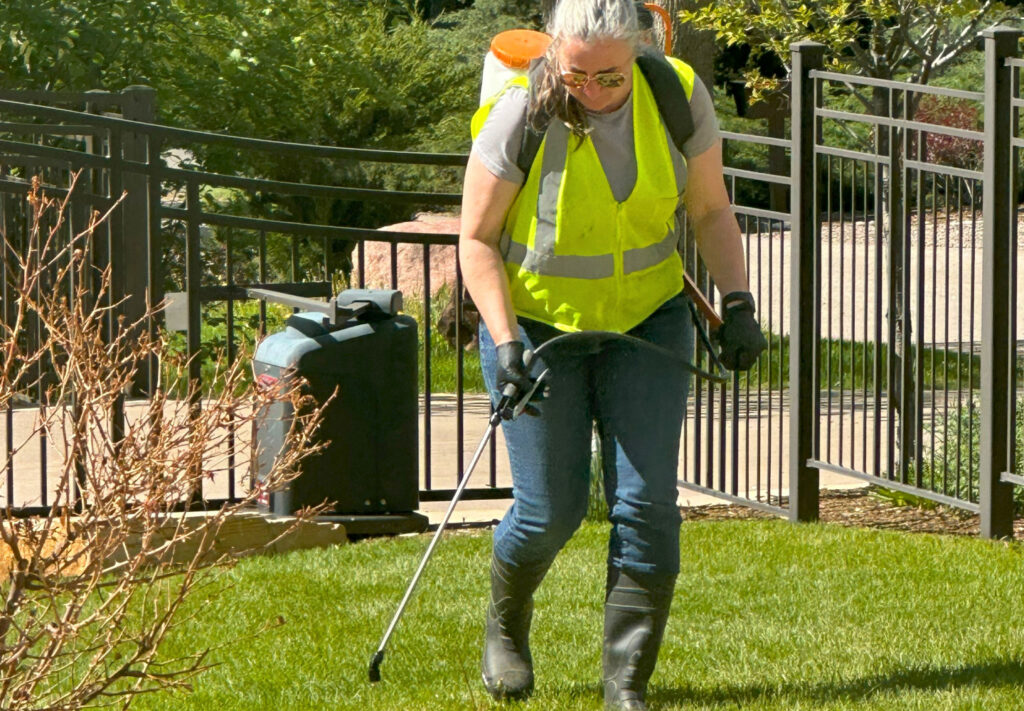Aug 2024 | Native Edge Landscapes
The transition from the heat of summer to the cool crispness of fall on Colorado’s Front Range is the perfect time to focus on organic lawn care. These months are pivotal for setting your lawn up for success in the coming year. Here’s a guide to help you nurture a healthy, sustainable lawn without relying on chemical inputs.
1. Adjust Mowing Practices
As temperatures begin to drop, it’s essential to adjust your mowing practices. Keep your mower blades sharp and raise the mowing height to about 3-3.5 inches. This height allows the grass to shade the soil, which helps retain moisture and reduces the likelihood of weed growth.

2. Aeration
Late August through September is the ideal time to aerate your lawn. Aeration relieves soil compaction, improves root growth, and enhances the lawn’s ability to absorb water and nutrients. Core aeration is preferred, where small plugs of soil are removed and left on the lawn. This method opens up the soil without causing too much disturbance, allowing your grass to breathe and thrive.
3. Overseeding
After aeration, it’s time to overseed. Cooler temperatures make it the perfect season to introduce new grass varieties that are drought-resistant and well-suited to Colorado’s climate. Choose a mix of grasses that includes perennial ryegrass, Kentucky bluegrass, and fescue, which are known for their hardiness in the region. Make sure to spread the seed evenly, focusing on bare or thin spots, and then water lightly to encourage germination.
4. Compost Tea
Soaking your lawn with a nutrient and biologically active compost tea adds beneficial microorganisms to soils, improves soil structure, and provides a slow-release source of nutrients to plants and lawns. The result? Improved health, resiliency and beauty of your landscape as the growing season comes to an end and winter approaches.
5. Watering Wisely
As fall approaches, adjust your watering schedule to reflect cooler temperatures and shorter days. Reduce watering to about once or twice a week, ensuring that your lawn receives about 1 inch of water per week, including rainfall. Watering deeply and less frequently encourages deep root growth and helps your lawn become more drought-resistant.
6. Natural Fertilization
Organic lawn care emphasizes feeding the soil rather than just the grass. In early September, apply an organic fertilizer that’s high in potassium to help strengthen your lawn as it prepares for winter dormancy. Potassium supports root growth and enhances your lawn’s resistance to stress and disease. Choose fertilizers that are OMRI-listed (Organic Materials Review Institute) to ensure they are free of synthetic chemicals.
7. Weed Control
Fall is an excellent time to tackle weeds that are preparing to set seed. Instead of reaching for chemical herbicides, consider using a corn gluten meal, which is a natural pre-emergent herbicide. It can help prevent weed seeds from germinating without harming your existing grass. For any existing weeds, hand-pulling is an effective method, especially after rain when the soil is softer.

8. Preparing for Winter
As you approach late September, begin preparing your lawn for winter. Gradually lower your mowing height to about 2.5 inches in the final mow of the season. This height helps prevent snow mold and other winter diseases. Continue to rake up fallen leaves and debris to keep your lawn clean and healthy.
Final Thoughts
Maintaining a healthy, green lawn in Colorado’s Front Range requires attention to detail, particularly as the seasons change. By focusing on organic practices during August and September, you can create a resilient lawn that thrives with minimal chemical inputs. Not only will your lawn look beautiful, but it will also contribute to a healthier environment for you, your family, your pets and local wildlife.
Get In Touch
To schedule a consultation or request services please call 303-245-9166, send an email to information@nativeedgelandscapes.com or Get In Touch through our website. One of our Customer Care Representatives will be happy to help.
